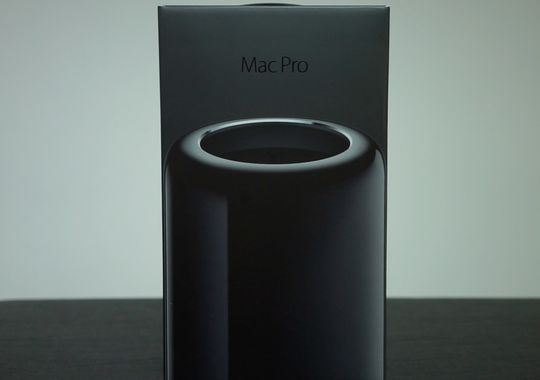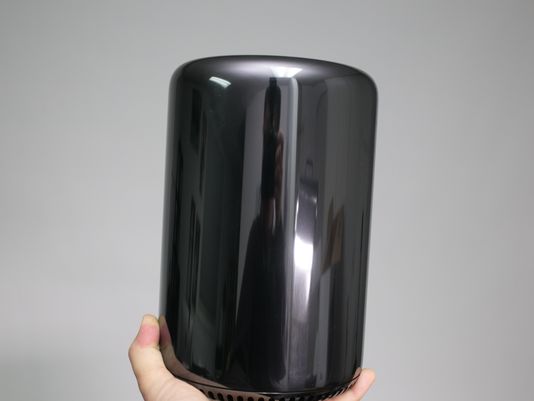Review: Apple Mac Pro small but super powerful
Jefferson Graham reviews Apple's new Mac Pro super-computer, aimed at creative professionals.
LOS ANGELES — Apple quietly slipped a shiny, new computer onto store shelves last week, and it's super fast and really small.
Geared toward pros as an engineering marvel, the new Mac Pro is clearly one of the great ones from the house of Apple. It's the fastest, most powerful computer Apple has ever produced, yet it fits easily on a shelf, replacing the old Mac towers.
It looks striking — like an ultra shiny round trash can, but, oh, only if our trash cans had this kind of power.
I've been playing with an early review unit for the past few days and can report that this new, top-of-the-line and pricey computer (starting at $2,999) is as fast as Apple says, and really quiet. It's a joy to use.
The specs are amazing: just 9.9 inches tall (that's smaller than the entry-level 11-inch MacBook Air laptop when extended fully), 6.6 inches in diameter and weighs 11 pounds. By comparison, the earlier Mac Pro model was 20 inches high, and weighed 40 pounds.
The new Mac Pro has quad-core or 6-core processors, depending upon your model and dual graphic cards. They start with 12 GB of RAM (compared to the 8 RAM that come standard on the top of the line iMac) and room for expansion up to 64 GB.
Apple promises a performance speed of two times faster — which is what I found in my tests. For instance, it took five minutes to transfer a 20 GB folder of video onto the Mac Pro, vs. 10 minutes on my souped-up iMac. An export of a video file from Final Cut Pro X video editing software took three minutes to complete on the Mac Pro, vs. six minutes on the iMac.
The Mac Pro is aimed at the "creative professional," videographers and editors, photographers, architects, designers, animators — folks who work with really big files and can't afford to wait around for their computers to process slowly.
Its release seems mostly oriented toward video professionals, many of whom Apple lost when the company re-jiggered its Final Cut video editing program to an easier to use prosumer program in 2011.

The MacPro box.(Photo: Sean Fujiwara)
New Final Cut features were added to coincide with the release of the Mac Pro, most notably the ability to edit high resolution 4K video footage and export an uncompressed file for viewing directly onto one of those new, ultra HD 4K TVs. (Readers: the changes only work if you have Apple's latest operating system upgrade, Mavericks, which is available for free[1].)
In gearing up for the new Mac Pro, Apple says it designed the computer from the ground up, to take advantage of new technologies like 4K video.
The Mac Pro has an HDMI port on the back of the unit, but it's not the first Mac to have HDMI. Two MacBook laptops have them. But the Mac Pro/Final Cut combo is the only Mac solution to process uncompressed 4K footage and watch it that way on a TV monitor.
I don't have 4K footage lying around, but I did try several exercises suggested by Apple with Final Cut – basically stuffing tons of clips and graphics on the video timeline to see whether the computer could process and play them without hiccups. Mission accomplished. Consider me very impressed.
Additionally, Apple made another seemingly minor, but major change in Final Cut, introducing "Libraries," which house your work project instead of the previous Event/Project duo. Now, editors can hand off their projects and work side by side with them on multiple computers.
For a company that has always been favored by creative pros, Apple needed this new super Mac Pro badly. The company has for the first time been getting serious competition from the Windows world, which started to make inroads with creative pros looking for stronger computers to process complicated animation and 3-D productions.
Apple produced a real winner with the Mac Pro, which, let's face it, is the first seriously innovative product to come from the Apple shop since the launch of the iPad in 2010. (Everything else has been marginal upgrades of previously released products.)
Could this mean the beginning of more innovation in 2014? Let's hope so.
Readers: will you be trading in your iMacs for MacPros? Let's discuss it on Twitter, where I'm @jeffersongraham[2].
References
- ^ http://www.apple.com/osx/ (www.apple.com)
- ^ http://twitter.com/jeffersongraham (twitter.com)










